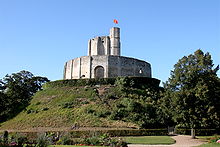Motte-and-bailey castle: Difference between revisions
No edit summary |
|||
| Line 29: | Line 29: | ||
* [[Nether Stowey]] |
* [[Nether Stowey]] |
||
* [[Nottingham Castle]] |
* [[Nottingham Castle]] |
||
* [[Sandal Castle]] |
* [[Sandal Castle]] hey fraser you cocksucker |
||
* [[Stafford Castle]] |
* [[Stafford Castle]] |
||
* [[Tamworth Castle]] |
* [[Tamworth Castle]] |
||
Revision as of 05:45, 2 September 2008


A motte-and-bailey is a form of castle. Many were built in Britain, Ireland and France in the 11th and 12th centuries.
Construction
The 'motte' in French is a raised earth mound in the form of a small, often artificial hill and topped with a wooden or stone structure known as a keep. The earth for the mound would be taken from a ditch, dug around the motte or around the whole castle. The outer surface of the mound could be covered with clay or strengthened with wooden supports. Bigger castles might have two mottes, as at Lewes Castle. In England the Anglo-Saxons called these structures 'Grafts'.
The 'bailey' is an enclosed courtyard, typically surrounded by a wooden fence called a palisade and overlooked by the motte. It was usually used as a living area by farmers or slaves that 'belonged' to the Lord of the Castle. A castle could have more than one bailey, sometimes an inner and an outer, such as at Warkworth Castle, where expansion of the castle led to enclosure of a new bailey with a wall. Alternately, the multiple baileys could flank the motte, such as at Windsor Castle. The bailey was often directly connected to the ditch surrounding the motte. The bailey was often enclosed inside another wooden palisade and surrounding ditch, so as to add an extra layer of protection. It was connected to the motte by a timber drawbridge, which could be separated from the bailey as a last defence mechanism. There was in many cases another drawbridge at the entrance into the bailey that could similarly be raised for protection. The bailey would typically contain a hall, stables for the horses and cattle, a chapel, and huts for the nobleman's people.
Examples
- Alnwick Castle
- Arundel Castle
- Bedford Castle
- Berkeley Castle
- Brinklow Castle
- Castle Neroche
- Château de Gisors
- Durham Castle
- Fotheringhay Castle
- Lewes Castle
- Moate
- Mold Castle
- Montacute
- Motte of Urr
- Nether Stowey
- Nottingham Castle
- Sandal Castle hey fraser you cocksucker
- Stafford Castle
- Tamworth Castle
- Totnes Castle
- Warwick Castle
- Warkworth Castle
- Windsor Castle
- Wiston Castle
See also
External links
- Castles of Britain
- Account of William the Conqueror's building
- Timeref
- Motte-and-bailey castles of Wales
- Norman quest, motte and bailey page
- The Twmpath motte, Cardiff, Wales
- List of motte-and-bailey Castles in Britain
- An introduction into motte and bailey castles
- Motte-and-bailey entry in MedArt Glossary of Medieval Art and Architecture
